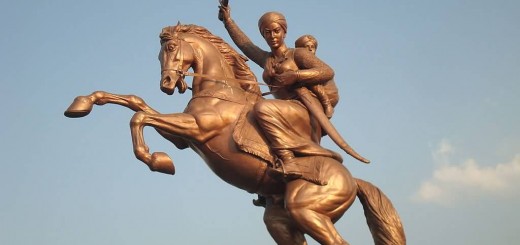10 Tourist Places In Gujrat

Sindhi Shoes (Photo Credit: Meena Kadri / CC BY 2.0)
Bhuj
Bhuj is a city and a municipality in Kutch district in the state of Gujarat, India. Bhuj is a beautiful little town in Kutch district, Gujarat. It was founded in the year 1510 by a local ruler, called Maharao Hamir. The place was laid siege and take control of by Rao Khengarji I, another ruler who made the town the capital of his kingdom in the year 1549. Some of the parts of the old Bhuj were ruined during the course of the time. The place assumed the role of a self-governing state during the British reign in India.

Passage To India Bhuj (Photo Credit: nevil zaveri / CC BY 2.0)
Bhuj is a famous destination for shopping of handicraft work like bandhni, leather work. Artists of nearby villages bring their art work for sale in Bhuj haat which is situated near jubilee ground. Bhuj is famous for jolly nature of citizens, usually they go to surrounding of Hamirsar lake to relax. Bhuj is also famous for its food specially Pakvans, dabelies. Bhuj is famous for his Gujarati thali which is unlimited Gujarati food, Hotel green rock near bus station is good place to have Gujarati thali.
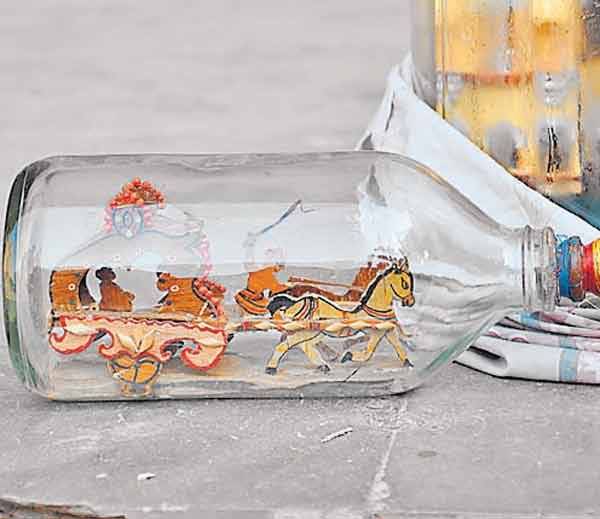
Amazing Work (Photo Credit: Kaushik Patel / CC BY 2.0)
Great Rann of Kutch

Rann Of Kutch White Desert (Photo Credit: Superfast1111 / CC BY-SA 3.0)
The Great Rann of Kutch is a seasonal salt marsh located in the Thar Desert in the Kutch District of Gujarat, India and the Sindh province of Pakistan. It is about 7,505.22 square km in size and is reputed to be the largest salt desert in the world. This area has been inhabited by the Kutchi people.
The name “Rann” comes from the Hindi word ran meaning “desert”. The Hindi word is derived from Sanskrit/Vedic word attested in the Rigveda and Mahābhārata. As early as 325 BCE, Alexander the Great was aware of the area.

Rann Utsav (Photo Credit: Narendra Modi / CC BY-SA 2.0)
The Government of Gujarat hosts an annual 3 month long festival called the Rann Utsav, where tourists can see the various sights of the Rann as well as get a taste of the local culture, cuisine and hospitality. Specially built local houses are also used to house tourists to give them a taste of them. Many adventure clubs and travel clubs organize expeditions.
The unique handicrafts of Kutch are world famous. A lot of women and young girls make their living by selling different types of embroidered cloths. The embroidery is of various styles such as Rabari, Ahir, Sindhi, Banni, Mutwa, Ari and Soof – and some styles include mirror or bead inlay.

Rann Of Kutch Highest Point (Photo Credit: Superfast1111 / CC BY-SA 3.0)
Gir National Park

Forest Department Tourist Information Center (Photo Credit: વિહંગ / CC BY-SA 3.0)
The Gir Forest National Park and Wildlife Sanctuary is a forest and wildlife sanctuary in Gujarat, India. Established in 1965, with a total area of 1412 km² , the park is located 43 km in the north-east from Somnath, 65 km to the south-east of Junagadh and 60 km to south west of Amreli.
It is the sole home of the Asiatic lions and is considered to be one of the most important protected areas in Asia due to its supported species. The ecosystem of Gir, with its diverse flora and fauna, is protected as a result of the efforts of the government forest department, wildlife activists and NGOs. The forest area of Gir were the hunting grounds of the Nawabs of Junagadh.

Chital (Photo Credit: Bernard Gagnon / CC BY-SA 3.0)
However, faced with a drastic drop in the lion population in Gir, Nawab Sir Muhammad Rasul Khanji Babi declared Gir as a “protected” area in 1900. His son, Nawab Muhammad Mahabat Khan III later assisted in the conservation of the lions whose population had plummeted to only 20 through slaughter for trophy hunting.
The 14th Asiatic Lion Census 2015 was conducted in May 2015. In 2015, the population has been 523. The population was 411 in 2010 and 359 in 2005. The population of lions in Junagadh District has been 268, Gir Somnath District has been 44, Amreli District has been 174 and Bhavangar District has been 37. There are 109 males, 201 females and 213 young/cubs.

Monitor lizard (Photo Credit: Bernard Gagnon / CC BY-SA 3.0)
Wild Ass Sanctuary
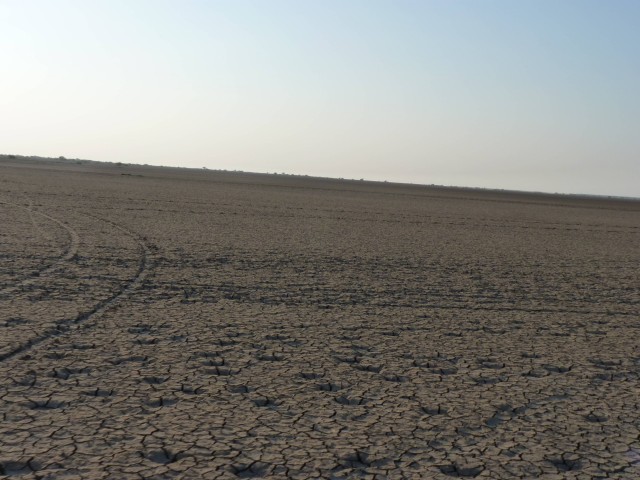
Rann Of Kutch Landscape (Photo Credit: chinmayi s k / CC BY-SA 4.0)
Indian Wild Ass Sanctuary also known as the Wild Ass Wildlife Sanctuary is located in the Little Rann of Kutch in the Gujarat state of India. Spread over 4954 km², it is the largest wildlife sanctuary in India.
The wildlife sanctuary was established in 1972 and came under the Wildlife Protection Act of 1972. The sanctuary is one of the last places on earth where the endangered wild ass sub-species Indian Wild Ass belonging to Asiatic Wild Ass species Onager can be spotted.

Wild Ass India (Photo Credit: Sballal / CC BY-SA 4.0)
The Rann of Kutch is a saline desert. During monsoon, the Rann gets flooded for a period of about one month and is dotted with about 74 elevated plateaus or islands, locally called ‘bets’. These bets are covered with grass and feed the population of around 2100 animals.
The main threat faced by the sanctuary is the illegal salt panning activity in the area. 25% of India’s salt supply comes from panning activity in the area.
From the city of Bhuj various ecologically rich and wildlife conservation areas of the Kutch / Kachchh district can be visited such as Indian Wild Ass Sanctuary, Kutch Desert Wildlife Sanctuary, Narayan Sarovar Sanctuary, Kutch Bustard Sanctuary, Banni Grasslands Reserve and Chari-Dhand Wetland Conservation Reserve etc.

Argyroxiphium Sandwicense Waipahoehoe (Photo Credit: Karl Magnacca / CC BY-SA 2.0)
Somnath

Somnath Temple (Photo Credit: Nagarjun Kandukuru / CC BY 2.0)
The Somnath Temple located in Prabhas Patan near Veraval in Saurashtra on the western coast of Gujarat, India, is the first among the twelve Jyotirlinga shrines of Shiva. It is an important pilgrimage and tourist spot for pilgrims and tourists. The temple is considered sacred due to the various legends connected to it. Somnath means “Lord of the Soma”, an epithet of Shiva.

Somnath Mahadev (Photo Credit: Kaushik Patel / CC BY 2.0)
Somnath Temple is known as “the Shrine Eternal”. This legendary temple has been destroyed and rebuilt several times by Islamic kings and Hindu kings respectively. Most recently it was rebuilt in November 1947, when Vallabhbhai Patel visited the area for the integration of Junagadh and mooted a plan for restoration. After Patel’s death, the rebuilding continued under Kanaiyalal Maneklal Munshi, another minister of the Government of India.
The temple is open daily from 6AM to 9PM. There are 3 aarti daily; in the morning at 0700, at 1200 and in the evening at 1900.
It is also believed that this is the place where Krishna ended his lila on earth and left for his heavenly abode.

Modhera Dance Festival (Photo Credit: Kaushik Patel / CC BY 2.0)
Dwarka

Nageshwar Temple (Photo Credit: Dn9ahx / CC BY-SA 3.0)
Dwarka, also spelled Dvarka, Dwaraka, and Dvaraka, is a city and a municipality of Devbhoomi Dwarka district in the Gujarat state in India. It is located on the western shore of the Okhamandal Peninsula on the right bank of the Gomti creek. Dwarka, is one of the foremost Chardham, four sacred Hindu pilgrimage sites, and is one of the Sapta Puri, seven most ancient religious cities in the country. Dwarka is often identified with the Dwarka Kingdom, the ancient kingdom of Krishna and is believed to have been the first capital of Gujarat.
The legend of Krishna has been proved partially by scientific marine archaeological investigations conducted by the Marine Archaeology Unit of the National Institute of Oceanography and the Government of Gujarat. The final inference of these marine under water investigations is that “there was really a city which got submerged in Dwarka in 1500 BC and that the “architectural evidence and antiquities such as a seal and inscriptions go to indicate that it was the city of Mahabharata age”.

Dwarakadheesh Temple (Photo Credit: Shishirdasika / CC BY-SA 4.0)
The Dwarkadhish Temple dedicated to Krishna, located in Dwarka was originally built around 2,500 years ago but was destroyed by the Mughal rulers, and then was rebuilt in the 16th century. The temple is also the location of Sharda Peeth, one of the four peeths established by Adi Shankaracharya.
The temple town famous as pilgrimage centre for Hindus has important temples, such as the Rukmini Devi temple, the Gomti Ghat and its temples, and the Beyt Dwarka. There is also a lighthouse at the land end point of Dwarka. Dwaraka has been chosen as one of the heritage cities for HRIDAY – Heritage City Development and Augmentation Yojana scheme of Government of India.

At Bet (Photo Credit: T.sujatha / CC BY-SA 3.0)
Modhera

Sun Temple (Photo Credit: Sudhamshu Hebbar / CC BY 2.0)
The Sun Temple, Modhera, at Modhera in Gujarat, is a temple dedicated to the Hindu Sun-God, Surya. It is situated on the bank of the river Pushpavati, 25 km from Mehsana and 102 km from Ahmedabad. It was built in 1026 AD by King Bhimdev of the Solanki dynasty. In the present times, prayers are not offered in this temple. This temple is now under the supervision of Archaeological Survey of India.

Modhera Sun Temple (Photo Credit: Kaushik Patel / CC BY 2.0)
To create the enchantment and splendor of ancient history and rich cultural traditions, Modhera dance festival is scheduled to be held during the third week of January every year, after the festival of Uttarayan for three days in the backdrop of the Sun temple. Renowned Indian artist perform here and enthrall the audience. The objective is to present classical dance forms in an atmosphere they were originally presented in. The festival is organised by the Tourism Corporation of Gujarat.
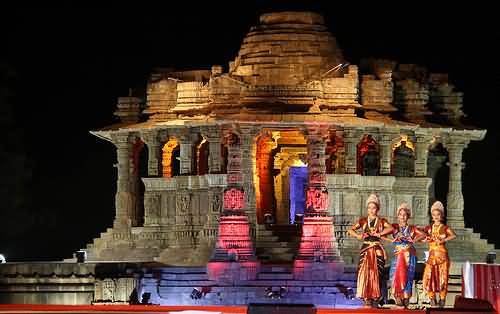
Modhera Dance Festival (Photo Credit: Kaushik Patel / CC BY 2.0)
Palitana
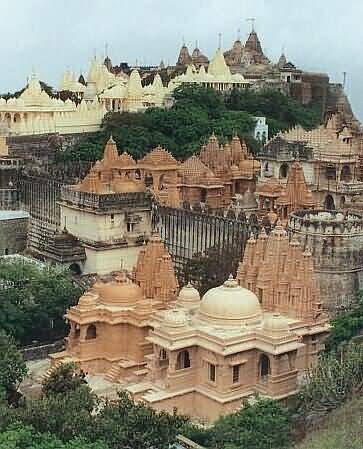
Palitana (Photo Credit: Malaiya / GFDL)
Palitana is a city in Bhavnagar district, Gujarat, India. It is located 50 km southwest of Bhavnagar city and is a major pilgrimage centre for Jains. Palitana is the world’s only mountain that has more than 900 temples. The Palitana temples and whole mountain are considered the most sacred pilgrimage place by the Jain community, and is the world’s largest Temple Complex. There are more than 3000 temples located on the Shatrunjaya hills, exquisitely carved in marble. The main temple on top of the hill, is dedicated to 1st tirthankar lord Adinath.
On the top the Shatrunjai Hill is a cluster of Jain temples, built by generations of Jains over a period of 900 years, from the 11th century onwards. The temples are managed by the Anandji Kalyanji Trust associated with the Kasturbhai Lalbhai group. From the foot of the hill to the top there are 3,800 and odd stone steps cut to facilitate climbing.

Palitana Temples (Photo Credit: Pratap Tur / CC BY-SA 3.0)
The temples are exquisitely carved in marble, veritable prayers in stone. To an observer, these appear to be ivory miniatures when seen from a distance. Created by master craftsmen, the most important temple is that of the first teerthankara, Shri Adishwar. It has ornate architectural motifs, though in its overall plan it is simpler than the Choumukh.
Other notable temples are those of Kumarpal, Vimalshah and Sampriti Raja. Kumarpal Solanki, a great Jain patron, probably built the earliest temple. The temple has a fabulous collection of jewels, and these can be seen with special permission. The temples date from 11th to the 20th century.

Palitana Rooftop (Photo Credit: tommy / CC BY-SA 2.0)
Mandvi

Mandvi Beach (Photo Credit: Meena Kadri / CC BY 2.0)
Mandvi is a city and a municipality in the Kutch district in the Indian state of Gujarat. It was once a major port of the region and summer retreat for Maharao of the Cutch State. The old city was enclosed in the fort wall and remains of the fort wall can still be seen. The city has a four-hundred-year-old ship building industry, which was started by the caste of Kharva that still builds small wooden ships. Mandvi has evidenced a great popularity in food items specially Pakvans and Dabeli which there by spread all over Gujarat and Maharastra.
Vijay Vilas Palace: The center of attractions at Mandvi is the Vijay Vilas Palace, a Royal abode set in the middle of well-laid gardens with water channels and marble fountains. The architect and craftsmen from Jaipur designed and constructed the palace in 1920 AD. The palace has all the elements of Rajput architecture and draws largely on the plan of palaces of Orchha and Datia.
The central high dome on the pillars, the Bengal domes on the sides, the windows with coloured glass, carved stone ‘jalis’, domed bastions at the corners, extended porch and other exquisitely stone-carved elements, make the palace worth visiting. The Vijay Vilas Palace has its own private beach which offers air-conditioned tented accommodation. Being private with conditional access it is a must visit for all beach lovers who want to enjoy their solitude and admire its Eco-friendly pristine beauty. For these reasons, this palace has been used as the set in many Hindi films and has now become a popular tourist destination.

Mandvi Kutch Gate (Photo Credit: Nizil Shah / CC BY-SA 1.0)
Mazar-e-Noorani: Here is the resting place of the 37th Dai-al-Mutlaq Syedna Noor Mohammad Nooruddin of the Dawoodi Bohra Community, a subsect of Shia Islam. People of Dawoodi Bohra Community come here in large numbers for Ziyarat.
Swaminarayan Temple at Mandvi: This scenic temple is on the main road of Mandvi – Naliya. The Wind Farms Beach and Wind-mills, which line the horizon of Mandvi, offer a spectacular view from the Mandvi sea-beach. The Wind mills projects running in this beach was Asia’s 1st Wind-Mills Projects in 1983.
Rukmavati bridge: The bridge on the Rukmavati River was built in 1883; it is the longest existing structure of its kind in India today. This bridge was built by Vishram Karman Chawda of Chandiya belonging to the Mestri community,etc.

Basking Finished In The Sun (Photo Credit: Satish Krishnamurthy / CC BY 2.0)
Gandhi’s Ashram

Riverfront Gandhi Ashram (Photo Credit: Abhishek.ujoshi / CC BY-SA 3.0)
The Kochrab Ashram was the first ashram in India organized by Mohandas Gandhi, the leader of the Indian independence movement, and was gifted to him by his friend Barrister Jivanlal Desai. Founded in May, 1915, Gandhi’s Kochrab Ashram was located near the city of Ahmedabad in the state of Gujarat.
This ashram was a major centre for students of Gandhian ideas to practise satyagraha, self-sufficiency, Swadeshi, work for the upliftment of the poor, women, and untouchables, and to promote better public education and sanitation. The ashram was organized on a basis of human equality, self-help, and simplicity.
However, as Kochrab became infested with plague after two years, Gandhi had to relocate his ashram, this time to the bank of the Sabarmati River. During his time at the Sabarmati Ashram Gandhi’s reputation as the voice of the masses and as the leader of the nation would further increase.

Gandhi Ashram (Photo Credit: Umar / CC BY-SA 3.0)

